PONTIAC GRAND AM 1997 Owners Manual
Manufacturer: PONTIAC, Model Year: 1997, Model line: GRAND AM, Model: PONTIAC GRAND AM 1997Pages: 371, PDF Size: 18.14 MB
Page 281 of 371
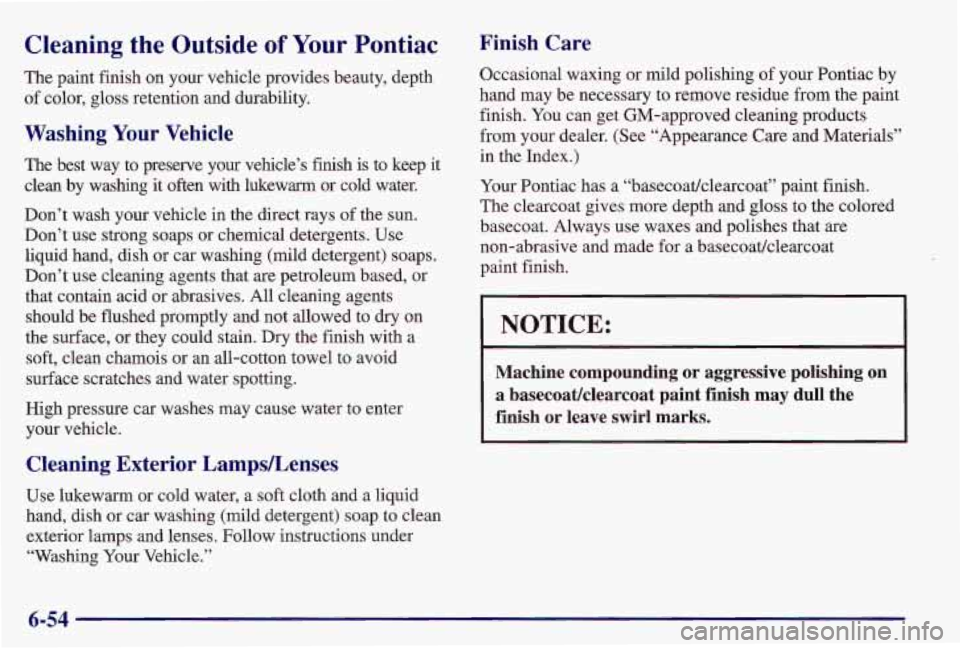
Cleaning the Outside of Your Pontiac
The paint finish on your vehicle provides beauty, depth
of color, gloss retention and durability.
Washing Your Vehicle
The best way to preserve your vehicle’s finish is to keep it
clean by washing it often with lukewarm or cold water.
Don’t wash your vehicle in the direct rays of the sun.
Don’t use strong soaps or chemical detergents. Use
liquid hand, dish or car washing (mild detergent) soaps.
Don’t use cleaning agents that are petroleum based, or that contain acid or abrasives. All cleaning agents
should be flushed promptly and not allowed
to dry on
the surface, or they could stain. Dry the finish with a
soft, clean chamois or an all-cotton towel to avoid
surface scratches and water spotting.
High pressure car washes may cause water to enter
your vehicle.
Cleaning Exterior Larnpshenses
Use lukewarm or cold water, a soft cloth and a liquid
hand, dish or car washing (mild detergent) soap to clean
exterior lamps and lenses. Follow instructions under
“Washing Your Vehicle.”
Finish Care
Occasional waxing or mild polishing of your Pontiac by
hand may be necessary to remove residue from the paint
finish. You can get GM-approved cleaning products
from your dealer. (See “Appearance Care and Materials”
in the Index.)
Your Pontiac has a “basecoat/clearcoat” paint finish.
The clearcoat gives more depth and gloss to the colored
basecoat. Always use waxes and polishes that are
non-abrasive and made for a basecoatklearcoat
paint finish.
I I
NOTICE:
Machine compounding or aggressive polishing on
a basecoatklearcoat paint finish may dull the
finish
or leave swirl marks.
6-54
Page 282 of 371

Foreign materials such as calcium chloride and other salts, ice melting agents, road oil and tar, tree sap, bird
droppings, chemicals from industrial chimneys, etc., can
damage your vehicle’s finish if they remain on painted
surfaces. Wash the vehicle as soon as possible. If
necessary, use non-abrasive cleaners that are marked
safe for painted surfaces to remove foreign matter.
Exterior painted surfaces are subject to aging, weather and chemical fallout that can take their toll over a period
of years. You can help to keep the paint finish looking
new by keeping your Pontiac garaged or covered
whenever possible.
Cleaning Aluminum Wheels
(If Equipped)
Keep your wheels clean using a soft clean cloth with
mild soap and water. Rinse with clean water. After
rinsing thoroughly,
dry with a soft clean towel. A wax
may then be applied.
The surface
of these wheels is similar to the painted
surface of your vehicle. Don’t use strong soaps,
chemicals, abrasive polishes, abrasive cleaners or
abrasive cleaning brushes on them because
you could
damage the surface. Don’t take
your vehicle through an automatic car wash
that has silicon carbide tire cleaning brushes. These
brushes can also damage the surface of these wheels.
Cleaning Tires
To clean your tires, use a stiff brush with a tire cleaner.
NOTICE:
When applying a tire dressing always take care to
wipe off any overspray or splash from all painted
surfaces
on the body or wheels of the vehicle.
Petroleum-based products may damage the
paint finish.
Sheet Metal Damage
If your vehicle is damaged and requires sheet metal
repair
or replacement, make sure the body repair shop
applies anti-corrosion material to the parts repaired or
replaced to restore corrosion protection.
6-55
Page 283 of 371
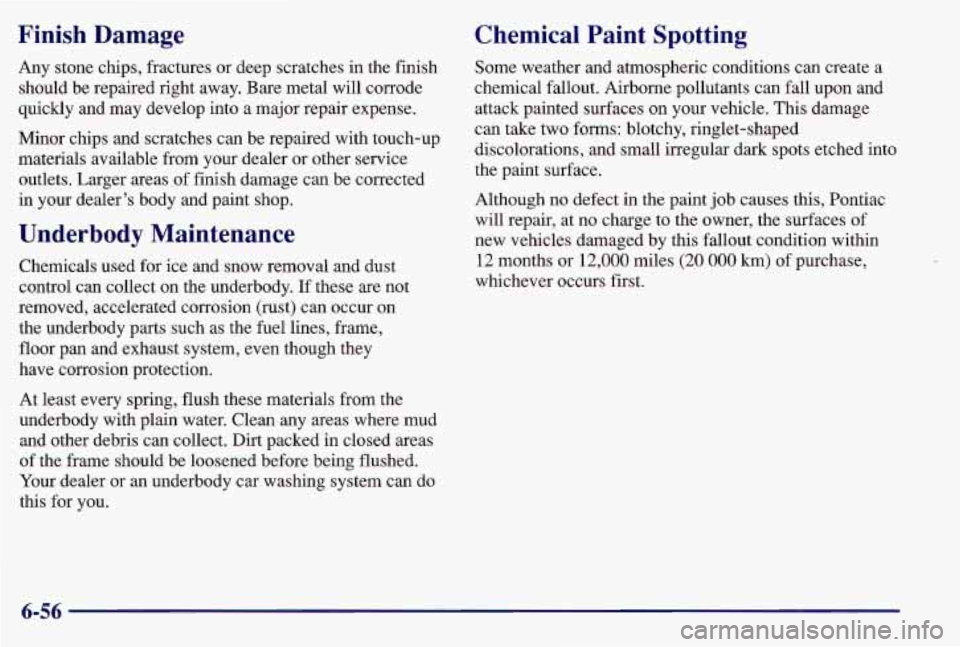
Finish Damage
Any stone chips, fractures or deep scratches in the finish
should be repaired right away. Bare metal will corrode
quickly and may develop into a major repair expense.
Minor chips and scratches can be repaired with touch-up
materials available from your dealer or other service
outlets. Larger areas of finish damage can be corrected
in your dealer’s body and paint shop.
Underbody Maintenance
Chemicals used for ice and snow removal and dust
control can collect on the underbody. If these are not
removed, accelerated corrosion (rust) can occur on
the underbody parts such as the fuel lines, frame,
floor pan and exhaust system, even though they
have corrosion protection.
At least every spring, flush these materials from the
underbody with plain water. Clean any areas where mud
and other debris can collect. Dirt packed in closed areas
of the frame should be loosened before being flushed.
Your dealer or an underbody car washing system can do
this for you.
Chemical Paint Spotting
Some weather and atmospheric conditions can create a
chemical fallout. Airborne pollutants can fall upon and
attack painted surfaces on your vehicle. This damage
can take two forms: blotchy, ringlet-shaped
discolorations, and small irregular dark spots etched into
the paint surface.
Although
no defect in the paint job causes this, Pontiac
will repair, at no charge to the owner, the surfaces of
new vehicles damaged by this fallout condition within
12 months or
12,000 miles (20 000 km) of purchase,
whichever occurs first.
6-56
Page 284 of 371
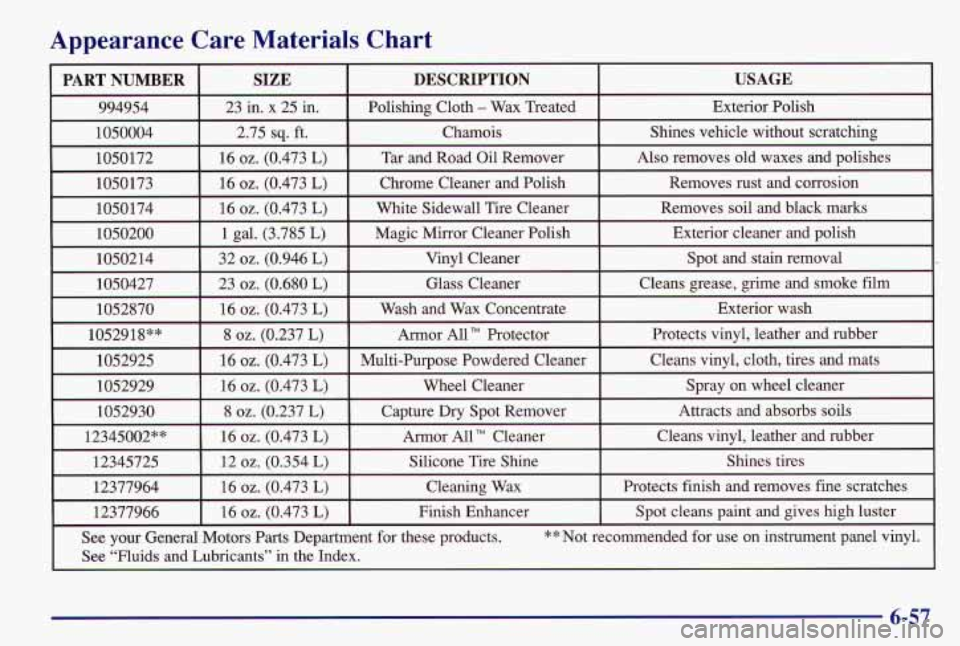
Appearance Care Materials Chart
6-57
Page 285 of 371

Vehicle Identification Number (VIN)
II 11111111 1111 111111 111 11111111 111111111111 111111111 11= e
bd SAMPLE4UXVM072675 bd
This is the legal identifier for your Pontiac. It appears on
a plate in the front corner of the instrument panel, on the
driver’s side. You can see it if you
look through the
windshield from outside your vehicle. The
VIN also
appears on the Vehicle Certification and Service Parts
labels and the certificates of title and registration.
Engine Identification
The 8th character in your VIN is the engine code. This
code will help you identify your engine, specifications
and replacement parts.
Service Parts Identification Label
You’ll find this label on your spare tire cover. It’s very
helpful
if you ever need to order parts. On this label is:
your VIN,
0 the model designation,
paint information and
0 a list of all production options and
special equipment.
Be sure that this label is not removed from the vehicle.
Electrical System
Add-on Electrical Equipment
I NOTICE:
Don’t add anything electrical to your Pontiac
unless you check with your dealer
first. Some
electrical equipment can damage your vehicle
and the damage wouldn’t be covered by your
warranty. Some add-on electrical equipment can
keep other components from working as
they should.
Your vehicle has an air bag system. Before attempting to
add anything electrical to your Pontiac, see “Servicing
Your Air Bag-Equipped Pontiac” in the Index.
6-58
Page 286 of 371
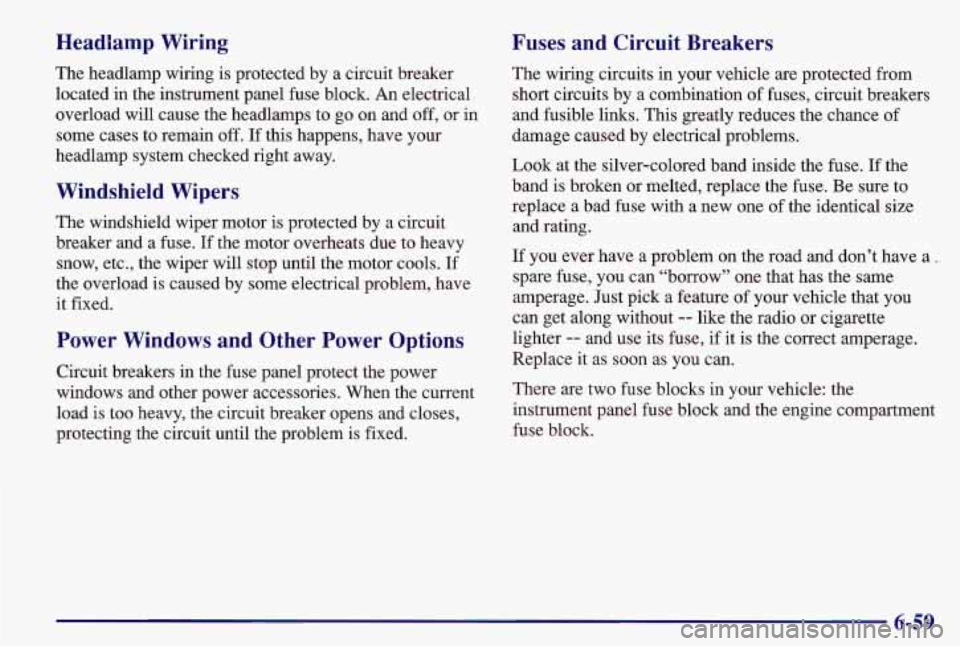
Headlamp Wiring
The headlamp wiring is protected by a circuit breaker
located in the instrument panel fuse block. An electrical
overload will cause the headlamps to go on and off, or
in
some cases to remain off. If this happens, have your
headlamp system checked right away.
Windshield Wipers
The windshield wiper motor is protected by a circuit
breaker and a fuse. If the motor overheats due to heavy
snow, etc., the wiper will stop until the motor cools.
If
the overload is caused by some electrical problem, have
it fixed.
Power Windows and Other Power Options
Circuit breakers in the fuse panel protect the power
windows and other power accessories. When the current
load is too heavy, the circuit breaker opens and closes,
protecting the circuit until the problem is fixed.
Fuses and Circuit Breakers
The wiring circuits in your vehicle are protected from
short circuits by a combination of fuses, circuit breakers
and fusible links. This greatly reduces the chance of
damage caused by electrical problems.
Look at the silver-colored band inside the fuse. If the
band is broken or melted, replace the fuse. Be sure to
replace a bad fuse with a new one of the identical size
and rating.
If you ever have a problem on the road and don’t have a
spare fuse, you can “borrow” one that has the same
amperage. Just pick a feature of your vehicle that you
can get along without
-- like the radio or cigarette
lighter
-- and use its fuse, if it is the correct amperage.
Replace
it as soon as you can.
There are two fuse blocks in your vehicle: the
instrument panel fuse block and the engine compartment
fuse block.
6-59
Page 287 of 371

Instrument Panel Fuse Block
I TURN 1 CRUISE
PWR ST
+ RDO IGN WIPER
I HTR-A/C I 02
DR LK 1
PRNDL I INST 1 INSTLPS
DR LK2 STOP HA2 RR DEF
I I
I 0 r U
The main fuse panel is located on the left side of the
instrument panel.
To access the fuses, open the fuse
panel door. Fuse
PWR WDO
TURN
Usage
Power Window (Circuit Breaker)
Turn Signal Lamps
6-60
Page 288 of 371
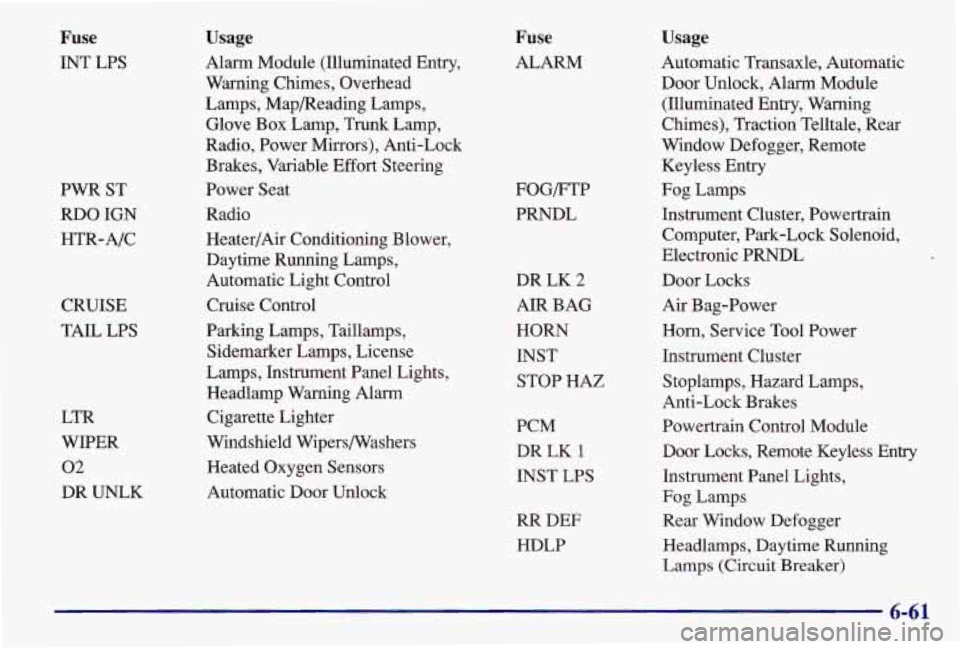
Fuse
INT LPS
PWR ST
RDO IGN HTR-A/C
CRUISE
TAIL LPS
LTR WIPER
02
DR UNLK
Usage
Alarm Module (Illuminated Entry,
Warning Chimes, Overhead
Lamps, Map/Reading Lamps,
Glove Box Lamp, Trunk Lamp,
Radio, Power Mirrors), Anti-Lock
Brakes, Variable Effort Steering
Power Seat
Radio Heater/Air Conditioning Blower.
Daytime Running Lamps,
Automatic Light Control
Cruise Control
Parking Lamps, Taillamps
,
Sidemarker Lamps, License
Lamps, Instrument Panel Lights,
Headlamp Warning Alarm
Cigarette Lighter
Windshield Wipers/Washers Heated Oxygen Sensors
Automatic Door Unlock
Fuse
ALARM
FOG/FTP
PRNDL
DR LK
2
AIR BAG
HORN
INST STOP HAZ
PCM
DR LK
1
INST LPS
RR DEF HDLP
Usage
Automatic Transaxle, Automatic
Door Unlock, Alann Module
(Illuminated Entry, Warning
Chimes), Traction Telltale, Rear
Window Defogger, Remote
Keyless Entry
Fog Lamps
Instrument Cluster, Powertrain
Computer, Park-Lock Solenoid.
Electronic PRNDL
Door Locks
Air Bag-Power
Horn, Service Tool Power
Instrument Cluster Stoplamps, Hazard Lamps,
Anti-Lock Brakes
Powertrain Control Module
Door Locks, Remote Keyless Entry
Instrument Panel Lights,
Fog Lamps
Rear Window Defogger
Headlamps, Daytime Running
Lamps (Circuit Breaker)
6-61
Page 289 of 371
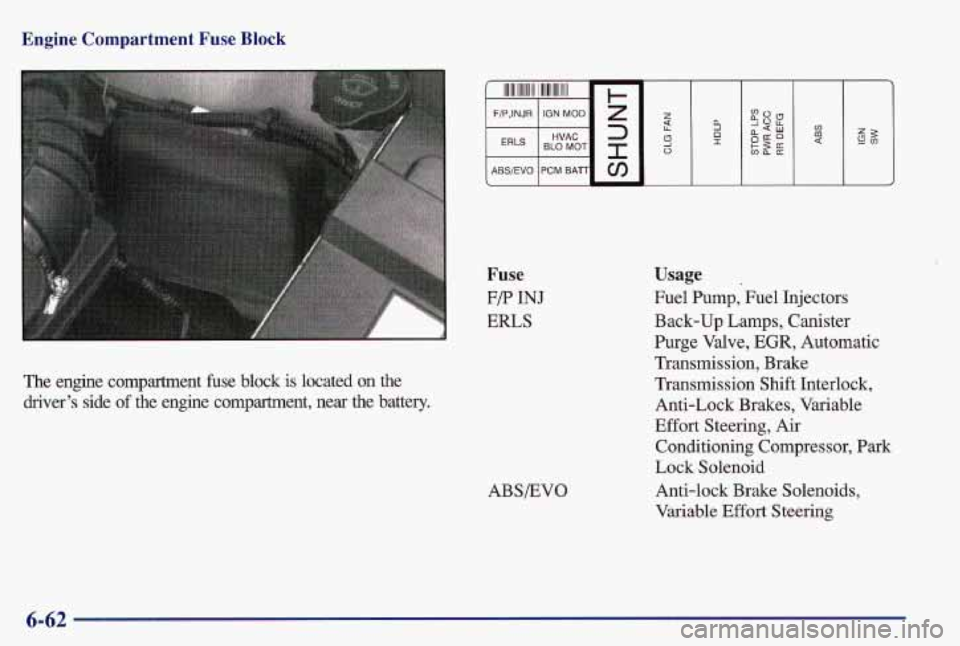
Engine Compartment Fuse Block
F/P,INJR I IGN MOD 1 L b1
ABSiEVO PCM BATT I
Fuse
F/P INJ
ERLS
The engine compartment fuse block
is located on the
driver’s side
of the engine compartment, near the battery.
ABSEVO
Usage
Fuel Pump, Fuel Injectors Back-up Lamps, Canister
Purge Valve, EGR, Automatic
Transmission, Brake
Transmission Shift Interlock,
Anti-Lock Brakes, Variable
Effort Steering, Air Conditioning Compressor, Park
Lock Solenoid
Anti-lock Brake Solenoids,
Variable Effort Steering
6-62
Page 290 of 371
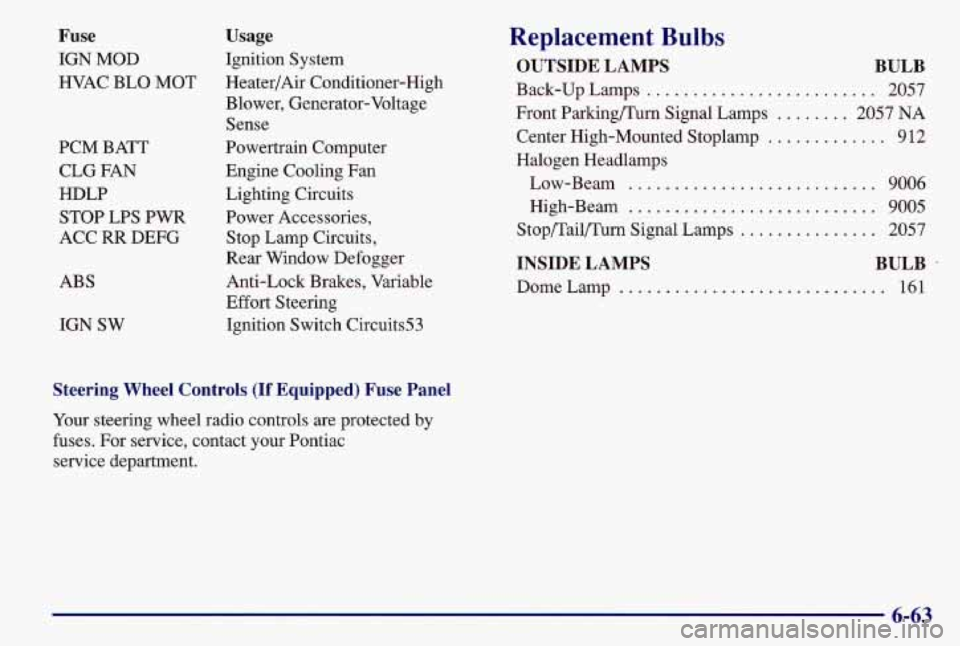
Fuse
IGN MOD
HVAC BLO
MOT
PCM BATT
CLG FAN
HDLP
STOP LPS PWR
ACC
RR DEFG
ABS
IGN
SW
Usage
Ignition System
Heater/Air Conditioner-High
Blower, Generator-Voltage Sense
Powertrain Computer
Engine Cooling Fan
Lighting Circuits
Power Accessories, Stop Lamp Circuits,
Rear Window Defogger
Anti-Lock Brakes, Variable
Effort Steering
Ignition Switch Circuits53
Steering Wheel Controls (If Equipped) Fuse Panel
Your steering wheel radio controls are protected by
fuses.
For service, contact your Pontiac
service department.
Replacement Bulbs
OUTSIDE LAMPS BULB
Back-up Lamps ......................... 2057
Front Parkingnurn Signal Lamps
........ 2057 NA
Center High-Mounted Stoplamp
... ... 912
Halogen Headlamps
Low-Beam
....... ,.. ........... 9006
High-Beam
........................... 9005
Stop/Tail/Turn Signal Lamps
............. 2057
INSIDE LAMPS
Dome Lamp .... .........
BULB
. 161
6-63